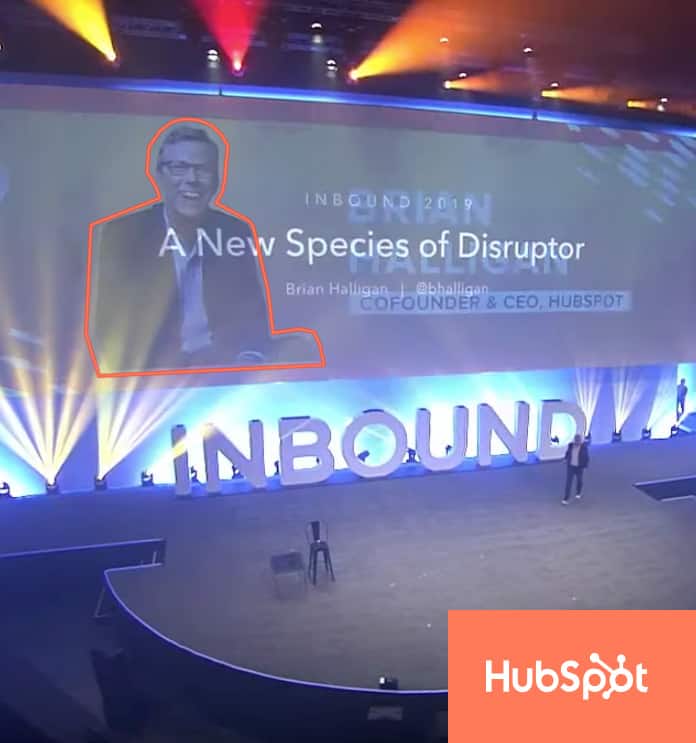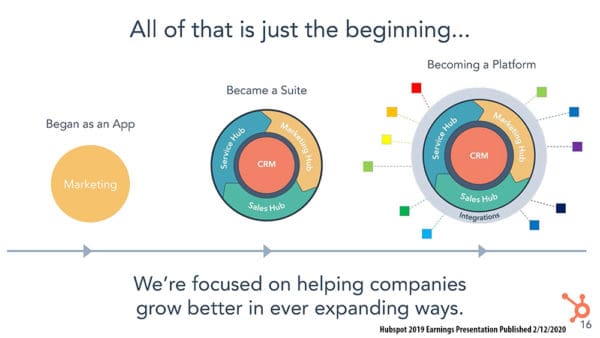HubSpot’s Evolving Ecosystem Opportunity (Part 1 of 2)
By

Behold the mighty Hubspot (NYSE: HUBS).
As of February 2020, Hubpsot has +73,000 customers organizations (customers) spending an average of almost $10,000 a year on its suite of SaaS “hubs” (Service, Marketing, and Sales, with CRM in the middle.)
In just 10 years, Hubspot grew from ~$15 million ARR to $675 million in 2019. In 2019 it’s revenue grew 33% YoY.
The calypso & lorax -colored planet is now the Saturn of SaaS, with all the revenue and growth to prove it.
Saturn’s Rings: The Growth of Hubspot’s App Partner Ecosystem
Growth is cool. But just as impressive to me is Hubspot’s rapid journey from simple marketing app to feracious “universal integration” partner platform.
Hubspot boasts that 94% of their customers have installed at least one Marketplace App.
And last September at Inbound ’19, it reported that customers use an average of five different integrations from its App Marketplace.
They also reported over 700,000 cumulative integration installs. Four months later (12/31/2019), that metric grew over 1 million.
With 43% activation growth in a single quarter, how soon before they pass 10 million installs? (My spreadsheet says Q3 of 2021, though 43% seems like an unreasonable pace to sustain.)
(Already wondering how can your SaaS get a piece of those mutual customers and installs? We can guide you!)
App to Suite to Platform
We often hear Hubspot leaders articulate a need to transform from “app to suite to platform.”
This transformation has become a pillar strategy for Hubspot’s next ten years.
We checked in on CEO Brian Halligan’s quarterly earning calls with Wall Street analysts, and the accompanying slide decks. (Check out the latest deck.)
Since mid-2018, the App-to-Suite-Platform transformation is regularly highlighted to investors as a sign of Hubspot’s maturation and momentum.
For example, Halligan said during the November 2019 earnings call (our emphasis added):
But HubSpot can’t live on suites alone. The reality is that a typical mid-market customer leans heavily on our applications, but also has about 40 other SaaS applications in their business. Our goal is to enable our customers to create a disruptive customer experience for their customers by orchestrating all those applications in their go-to market. We want to move from a suite company to a platform company.
Hubspot’s recent acquisition of PieSync further underscores the importance of integration to their customers. (Congrats to our friends running this outstanding integration platform!)
Hubspot’s transformation to platform resembles the Salesforce, Zendesk, and QuickBooks stories. But late to the platform party, Hubspot is studying their past growth experiences, and avoiding many pain points learned by the pioneers the hard way.
The result is an outstanding early developer experience that rewards quality code and thoughtful business case planning.
(Read our early insights into the Hubspot Developer Platform in part 2!)
All Aboard the Hubspot Train
Over the past two years we’ve seen Hubspot invest serious money and talent into growing its universe of integration partners. The team is growing and capable, with quick communication and agile documentation that reflects urgent feedback.
The team is headed by Scott Brinker, VP of Platform Ecosystem and the originator of that ubiquitous “MarTech 5000” eye chart that finds its way into so many conference decks. If anybody groks the power of a broad SaaS partner network, it’s the keeper of the original logo constellation slide.
Think your SaaS is ready for a Hubspot App? More than just a common tater, Left Hook is developing new apps on the platform every day.
In Part 2 of this post, we share six early observations an insights for SaaS leaders about to board this speeding success story.
So keep reading!


